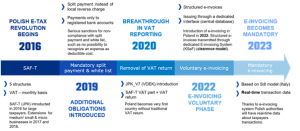Poland is a world leader in implementing digital tax requirements. There are already a lot of e-tax obligations in place in Poland, including SAF-T (JPK_V7 in particular), the ‘White List’ (Biała Lista), and electronic financial statements. Yet another one is coming into force in 2022, as Poland introduces structured e-invoicing. Initially, electronic invoicing will be voluntary, but is set to become mandatory in 2024.
Poland’s e-tax journey
Before diving into the e-invoicing details, it is worth recalling Poland’s e-tax journey, including its most important milestones.

The digital tax revolution in Poland began in 2016, when SAF-T (JPK) was introduced for large taxpayers. JPK was divided into five structures covering warehouse, general ledger, invoices, bank statements, and VAT evidence. VAT evidence (registers) had to be submitted on a monthly basis, whereas other structures were deliverable upon request of the tax authorities. In 2017 and 2018 medium-sized, small, and micro companies were covered by the SAF-T obligation.
2019 brings another tax development with a significant electronic factor. Most importantly, mandatory split-payments came into force, replacing the local reverse-charge mechanism. Additionally, since September 2019 Polish taxpayers have needed to make payments to vendors using only bank accounts registered in so-called White List database.
The real breakthrough in Polish VAT reporting took place in 2020, when the standard VAT return obligation was removed and fully replaced by the amended JPK_V7 file, which covered joint data from the former JPK_VAT and VAT return (VAT-7 form). In so doing, Poland became one of the very first countries to stop using typical VAT return reporting.
2022 and 2023 will bring another digital revolution in Polish VAT obligations. Initially it was expected that voluntary e-invoicing would enter into force in 2021. It was later decided to postpone the introduction of e-invoicing until 2022. Therefore, from January 2022 Polish taxpayers may opt to join the national e-invoicing system and start transmitting e-invoices. In this “pilot phase”, receiving e-invoices will require customer acceptance.
E-invoicing is set to become mandatory in 2024. Poland has already asked the European Commission for a permission (or ‘derogation’ in EU speak) to make e-invoicing obligatory.
A technical outline of Polish e-invoicing
Poland is introducing e-invoicing according to a clearance model, which is used in Italy, for example. This means there is a central e-invoicing system in which e-invoices are issued, received, stored, and validated. The Polish domestic e-invoicing system is called Krajowy System e-Faktur (KSeF), and it is maintained by the country’s tax authorities.
The majority of invoices currently transmitted between Polish taxpayers is electronic. However, they may have different formats and layouts. Therefore, Poland is implementing a standardized format of an e-invoices called the structured invoice (‘faktura ustrukturyzowana’). A structured invoice is defined as an invoice issued in KSeF with a unique ID assigned by the system to that particular invoice. It is no surprise that the format of the structured invoice is XML.

The Polish Ministry of Finance will publish free-of-charge applications to allow structured invoices in KSeF to be issued. However, companies issuing large numbers of invoices should consider connecting their ERP systems with the central e-invoicing infrastructure using dedicated API (application programming interface). Transmission of structured invoices through KSeF will require authorization either by qualified signature or by ‘Profil Zaufany’ (intended for small taxpayers).
A test environment has already been published, in which taxpayers and developers can verify their solutions and enable their use of KSeF infrastructure.
The content of structured invoices is very detailed. There are fields that allow the provision of information not only about mandatory invoice elements, but additional data often stated on invoices. For instance, there are fields covering data about purchase orders, Incoterms, and transport carriers.
It is also worth mentioning that some of the elements are in line with JPK_V7. For example, JPK_V7 requires the provision of GTU codes (for specific products supplied), which is not a mandatory element of an invoice. Structured invoices do not make it mandatory either, although there is a field “GTU”, where such information can be provided directly in the invoice. Such logic may be helpful in mapping data from invoices to various tax reports, including JPK_V7.
On the other hand, fields containing values have names that are the same as or similar to JPK invoices (JPK_FA). Therefore, although JPK_FA will finally no longer be required, some mappings already performed for the purpose of JPK invoices might also be used in developing a solution for KSeF.
Benefits coming from structured e-invoicing

There are plenty of benefits resulting from a national e-invoicing system based on structured e-invoices. One of the biggest is the standardized (structured) format of invoices. This is an important prerequisite for automating AP/AR processes, as each invoice has exactly the same format. Currently, there are many different layouts of invoices. Even advanced solutions (such OCR) are not perfect for the automation of invoice processing. Invoices issued in KSeF cannot be lost, so it will no longer be necessary to issue duplicates of invoices. Moreover, structured invoices are stored and archived centrally for 10 years. Therefore, companies do not need to invest in additional archiving solutions.
There are also already some specific incentives that are aimed at encouraging taxpayers to join the KSeF system in 2022. The most highlighted benefit seems to be the possibility of receiving VAT refunds quicker, in 40 days instead of 60. However, there is a very low limit of VAT refund that can be provided in 40 days. That limit is at the level of PLN 3,000 (about 600 Euro). Unfortunately, such “benefits” will not affect businesses’ decisions about whether to enter the KSeF voluntarily in 2022. It is hoped that this particular limit will be removed or at least changed to some reasonable level, as the idea behind this incentive itself has great potential.
Another benefit worth considering is the possibility of bypassing complex Polish regulations for reporting credit notes. In brief, companies issuing credit notes in KSeF do not need to analyse the documentation required to reduce their taxable base. Lastly, taxpayers issuing structured invoices will no longer be required to submit JPK invoices (JPK_FA), because tax authorities will already have information about their invoices in the KSeF system.
In 2022, issuing and receiving structured electronic invoices is not mandatory. However, it is still worth considering joining KSeF in the pilot phase in 2022, not only because of handy potential benefits, but also as a test of preparedness before obligatory e-invoicing comes into force in 2024.





